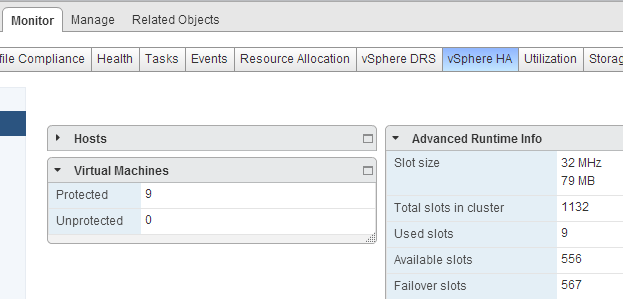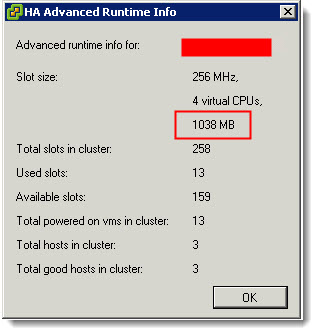- Vmware Memory Slot Size
- Vmware Slot Size Calculation
- Vmware Slot Size Chart
Slot Size Calculation Slot size is comprised of two components, CPU and memory. VMware HA calculates the CPU component by obtaining the CPU reservation of each powered-on virtual machine and selecting the largest value. In vSphere 5.0 and newer, a slot size is set at the highest reservation of memory or CPU. If there are no reservations, CPU is set at 32 MHz and memory is 0MB + Overhead (as defined in the Resource Management Guide). For more information, see the VMware vSphere Availability guide. If you work with VMware Workstation on your Windows PC, you've probably noticed how the virtual machine disk image can become quite large very fast, especially if you are running Windows 7 or Windows 10 as a guest OS. Luckily, there are a couple of ways you can shrink the size of the virtual disk to a more manageable size. But we do not use vCPUs anymore to determine the slot size for CPU. The slotsize for CPU is determined by the highest reservation or 256MHz (vSphere 4.x and prior) / 32MHz (vSphere 5) if no reservation is set. However, vCPUs can have an impact on your slot it can have an impact on your memory slotsize.
VMware slot sizes are an important topic if you’re concerned with how many ESXi hosts are required to run your environment.
What is a Slot?
To begin this post, we need to understand what a slot is. A slot is the minimum amount of CPU and memory resources required for a single VM in an ESXi cluster. Slot size is an important concept because it affects admission control.
A VMware ESXi cluster needs a way to determine how many resources need to be available in the event of a host failure. This slot calculation gives the cluster a way to reserve the right amount of resources.
How are Slots Sized?

The slot has two parts, the CPU component and the memory component. Each of them has its own calculation. If there are no virtual machine resource reservations in the cluster, then the slot size (for ESXi 5 at least) is 32 Mhz for CPU and 0 MBs + overhead for memory. (I’ve used 80 MBs as my memory overhead in the examples)
In the example below we have 2 ESXi hosts that have the same amount of resources available for virtual machines. There are different sized VMs, but none of them have a reservation. Doing a quick calculation we can determine that 384 slots are available on each host.
Memory Component: 49 GBs / 4024 MBs = 627 slots
We take the lower value between the CPU slot size and the memory slot size to determine the number of virtual machines that can be started up under admission control. So therefore we could safely start 384 machines on these ESXi hosts, have one fail, and have the other host start all of them.
(I should mention that it’s unlikely that you could get 384 vms on one of these hosts. That would be a great consolidation ratio.)
Problem Scenario
What if you have a single large VM with a reservation, but the rest of the virtual machines are relatively small.
Let’s look at the same environment, but this time let’s make the larger VM have a reservation on it.
Vmware Memory Slot Size
Memory Component: 49 GBs / 4024 MBs = 12 slots
Admission control is going to tell us that only 6 slots are available on host B, so it will only allow 6 VMs on host A to be powered on. Since I’m using a simplistic diagram with only two hosts, we know that these VMs will still fit on the host but since we use the largest slot size to determine how much we can fail over admission control will stop us from powering on VMs.

Option 1 – Don’t use reservations unless their is a good reason to do so.
Option 2 – We can manually configure the slot size on the cluster.
Navigate to the cluster settings and go to the HA Section, Click Edit and you’ll have the option of modifying the slot size. Note that if you do this, some of your VMs will require multiple slots to run. For instance the large VM we used in our example might take more than 1 slot depending on what size you make it. The button below the slot size configuration may help you determine how many VMs will be affected by this change.
If you’re curious about what the slot size is on your system, look at your cluster summary. There will be an item listed for slot size.
If you’re in a situation where you think you need to add extra ESXi hosts to your cluster because you can’t power on virtual machines without exceeding your admission control rules, take a look at your slot sizes first. It may save you some money on a host you don’t really need.
Vmware Slot Size Calculation
By Duncan Epping, Principal Architect.
On the VMTN forum today someone asked how it was possible that the “used slots” exceeded the “total slots”. This is what their environment showed in vCenter:

HA Advanced Runtime Info:
Slot size 4000Mhz
4 vCPUs,
4232MB
Total Slots in Cluster 16
Used Slots 66
Available Slots 0
Total Powered on vms in Cluster 66
Total Hosts in cluster 2
Total good host 2
You can imagine this person was very surprised to see this. How can you have 66 slots used and only 16 total slots available in your cluster? There are two possible explanations:

Vmware Slot Size Chart
- Admission Control is disabled
- A reservation was set on a virtual machine after all virtual machines were powered on, skewing the numbers

Let’s tackle number 1 first. If you disable admission control the vSphere UI will still show the slot size and the number of slots etc, it just won’t do anything with it…
With regards to the second explanation it might be easier to give an example:
Just imagine you have 2 hosts and HA does its calculations and you have 100 slots available. You power-on 100 VMs. Now you set a reservation on a VM, this reservation will change the slotsize. HA does it calculations again based on this new slotsize. This will result in only 25 slots available based on this new slotsize. However you already used 100 slots. In other words, now you have 25 totals slots and your used is 100.




